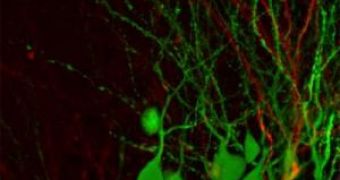Even if the neuronal genesis occurs primarily while in the mother's womb, certain areas in the mammal brain still produce new neurons throughout adulthood, like the hippocampus, a brain nucleus involved in memory and spatial perception.
Hippocampus neurons, specifically dentate granule cells, are continuously produced in post fetal life, in both juvenile and adult life. Scientists are curious how these new cells connect with other neurons and to which extent they resemble embryonic neurons, as inducing neuronal generation in other parts of the adult brain could ease function loss from trauma or degenerative conditions.
To see how each neuronal type integrates into brain circuits, the scientists had to distinguish between them. Using retroviruses, they tried to put different kinds of proteins into the embryonic neurons and post-embryonic neurons in the adult mouse brain, which fluoresced green in the first and red in the former, enabling the researchers tell apart the two types. They focused on glutamatergic (excitatory) nerves connecting the hippocampus with the entorhinal neocortex, another brain center linked to memory.
Stimulating the inputs from the entorhinal center to the hippocampus, the researchers observed similar responses in both types of neurons, thus their capacity of forming synapses is similar. The investigation of GABAergic (inhibitory) inputs from neuronal connection inside the hippocampus led to similar responses in frequency, amplitude, and kinetics between the two neuronal types. Trying to see how the two types of nerve cells send signals to produce an action potential, or spike to the subsequent neurons, the team discovered that spiking was not distinguishable between the two cell types.
As the "new" and the "old" neurons function practically in the same way, at least some neurons developed in fully grown brains can form connections that are indistinguishable from those of neurons appeared during the embryonic life, a hopeful discovery to repairing harmed or degenerated neuronal tissue.
Photo credit: Schindler et al.

 14 DAY TRIAL //
14 DAY TRIAL //